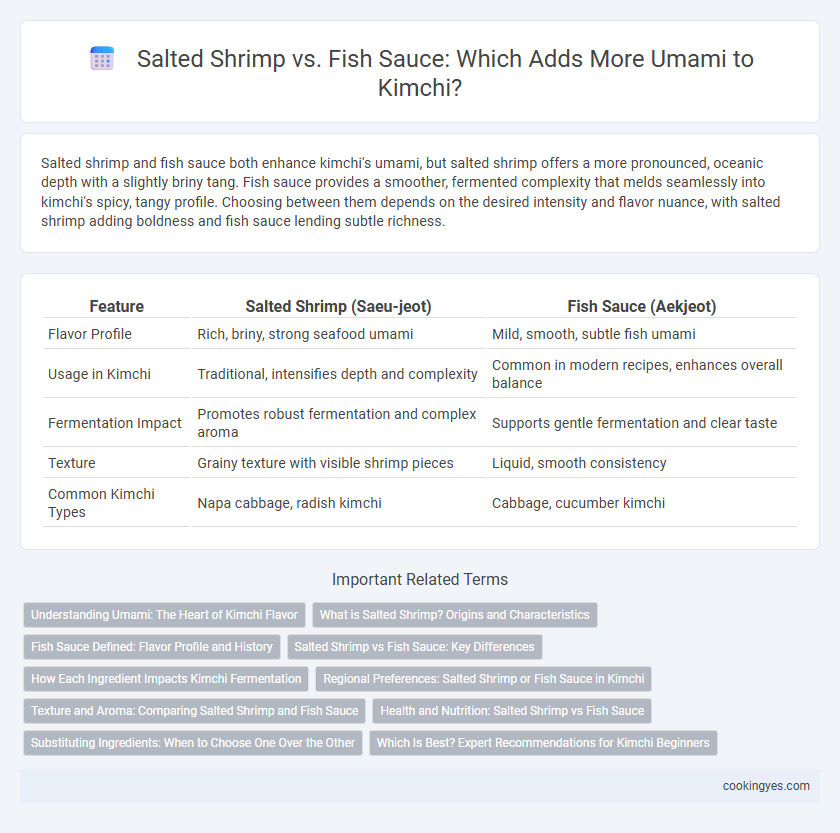Salted shrimp and fish sauce both enhance kimchi's umami, but salted shrimp offers a more pronounced, oceanic depth with a slightly briny tang. Fish sauce provides a smoother, fermented complexity that melds seamlessly into kimchi's spicy, tangy profile. Choosing between them depends on the desired intensity and flavor nuance, with salted shrimp adding boldness and fish sauce lending subtle richness.
Table of Comparison
| Feature | Salted Shrimp (Saeu-jeot) | Fish Sauce (Aekjeot) |
|---|---|---|
| Flavor Profile | Rich, briny, strong seafood umami | Mild, smooth, subtle fish umami |
| Usage in Kimchi | Traditional, intensifies depth and complexity | Common in modern recipes, enhances overall balance |
| Fermentation Impact | Promotes robust fermentation and complex aroma | Supports gentle fermentation and clear taste |
| Texture | Grainy texture with visible shrimp pieces | Liquid, smooth consistency |
| Common Kimchi Types | Napa cabbage, radish kimchi | Cabbage, cucumber kimchi |
Understanding Umami: The Heart of Kimchi Flavor
Salted shrimp and fish sauce are key umami contributors in kimchi, each enhancing the depth and complexity of flavor through fermented proteins. Salted shrimp imparts a rich, briny taste with subtle sweetness, while fish sauce provides a sharper, more intense savory note that elevates the overall umami profile. Understanding the balance between these ingredients is essential for achieving the characteristic savory richness that defines authentic kimchi.
What is Salted Shrimp? Origins and Characteristics
Salted shrimp, known as saeu-jeot in Korean cuisine, is a traditional fermented seafood ingredient made by salting small shrimp to enhance their flavor and preservation. Originating from Korea, salted shrimp contributes a rich umami depth and complex aroma unique to kimchi, distinguishing it from the clearer and more pungent taste of fish sauce. Its natural fermentation process adds beneficial probiotics, essential for the authentic tang and texture of classic kimchi recipes.
Fish Sauce Defined: Flavor Profile and History
Fish sauce, a staple in Korean and Southeast Asian cuisine, is a fermented condiment made from anchovies, salt, and water, offering a complex umami flavor with sweet, salty, and savory notes. Its history dates back over a thousand years, originating in ancient Asian fishing communities where fermentation was used to preserve fish and enhance taste. In kimchi, fish sauce imparts a deeper, more rounded umami richness compared to salted shrimp, balancing the tangy and spicy elements for a well-rounded flavor profile.
Salted Shrimp vs Fish Sauce: Key Differences
Salted shrimp and fish sauce are both essential for adding umami depth to kimchi, but they differ significantly in flavor intensity and texture contribution. Salted shrimp provides a rich, chunky texture and a strong, fermented seafood aroma, enhancing complexity and depth, while fish sauce offers a smoother, more liquid form with a sharp, salty, and slightly sweet taste that blends seamlessly into the kimchi paste. Choosing salted shrimp emphasizes a robust, traditional flavor profile, whereas fish sauce creates a balanced umami that melds easily with other ingredients for a subtler finish.
How Each Ingredient Impacts Kimchi Fermentation
Salted shrimp introduces complex amino acids and enzymes that enhance kimchi's fermentation by promoting beneficial bacterial growth, resulting in a richer umami flavor and firmer texture. Fish sauce contributes a deep savory taste through its concentrated glutamates and natural probiotics, accelerating fermentation and imparting a distinct aromatic profile. Both ingredients influence the microbial balance differently, with salted shrimp favoring lactic acid bacteria diversity while fish sauce encourages faster acidification and a more pronounced tang.
Regional Preferences: Salted Shrimp or Fish Sauce in Kimchi
Regional preferences for kimchi umami strongly influence whether salted shrimp or fish sauce is used, with salted shrimp favored in southern regions like Jeolla for its robust, briny depth. Fish sauce, particularly the clear, fermented varieties from coastal areas such as Gangwon, imparts a lighter, cleaner umami that highlights fresh vegetable flavors. These regional choices impact the flavor profile and fermentative character, shaping kimchi's unique taste across Korea.
Texture and Aroma: Comparing Salted Shrimp and Fish Sauce
Salted shrimp contributes a rich, crunchy texture and a pronounced umami flavor with a slightly briny aroma that enhances kimchi's complexity. Fish sauce offers a smoother, more liquid consistency, infusing kimchi with a deep, savory aroma and subtle sweetness that melds seamlessly into the fermentation process. The choice between salted shrimp and fish sauce directly influences kimchi's texture and aromatic profile, shaping its traditional sensory experience.
Health and Nutrition: Salted Shrimp vs Fish Sauce
Salted shrimp provides probiotics and essential amino acids that support gut health and digestion in kimchi, contributing to its rich umami flavor. Fish sauce contains a high concentration of antioxidants and omega-3 fatty acids, which promote cardiovascular health and enhance the depth of taste. Both ingredients offer unique nutritional benefits, but salted shrimp typically contains higher sodium levels, requiring moderation for individuals managing blood pressure.
Substituting Ingredients: When to Choose One Over the Other
Salted shrimp delivers a distinct briny depth and fermented seafood complexity that enhances traditional kimchi's umami, making it ideal when a richer, slightly pungent flavor is desired. Fish sauce offers a smoother, more balanced savory profile with a pronounced umami boost, suitable for milder kimchi variations or when a less intense seafood taste is preferred. Choosing between salted shrimp and fish sauce depends on the desired flavor intensity and texture, with salted shrimp providing chunkier texture and fish sauce blending seamlessly into the kimchi paste.
Which Is Best? Expert Recommendations for Kimchi Beginners
Salted shrimp and fish sauce are both essential umami enhancers in kimchi, but salted shrimp offers a more complex, fermented flavor preferred by many traditionalists. Expert recommendations for kimchi beginners highlight salted shrimp for its depth and balanced saltiness, which enhances the fermentation process without overpowering the cabbage. Fish sauce is suggested for those seeking convenience and a milder, more accessible umami profile during initial kimchi trials.
Salted Shrimp vs Fish Sauce for kimchi umami Infographic

 cookingyes.com
cookingyes.com